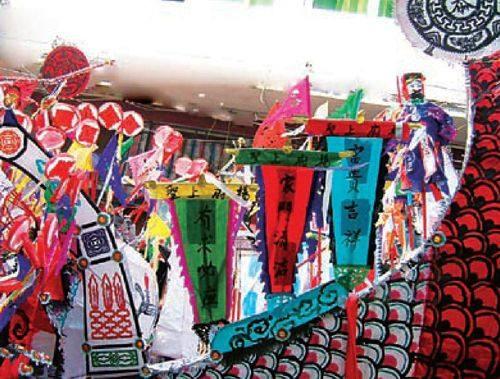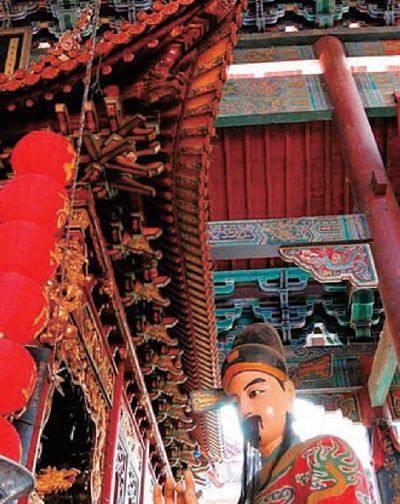鲸头之访
梅重



日前有事去温州,抽空跑了一趟鲸头杨府殿。
早就听说,杨府殿是我国东南沿海渔家、商家崇信的民间宗教场所,里面奉祀的神祇杨老爷能够庇护出海之人交通生产,颇为验证,习俗在浙、闽、粤诸省与港、澳、台,以及东南亚地区广为流播;嗣后因了某些历史缘故,其影响力明显衰退缩小,竟被晚出三百余年的天后宫里的妈祖超越,不过现在上述地方仍散落着五百多座殿庙,仅浙江的温州、台州就达两百,其中鲸头杨府殿声名较为响亮,因而心中一直存有好奇,总想参观瞻仰一番。
车路延伸,多在山野间穿行,偶尔弯环海角,极目而望,一片汪洋。
鲸头在苍南县云岩乡。云岩附近风光也优美,有浙南的大山玉苍山余脉和大水横阳江支派汇聚,但偏偏不濒海。在小摊上购一纸的导游图、几纸的导游册,得知过去这一带是古海湾,后由潮流带来的泥沙淤沉而变为内陆;心中试想,鲸头本应指山,半坡半崖的,形似而名,其下有小村子,村以山名;旧时人们从这里被称为南港的鲸头埠沿横阳支江出海航行渔作,顺理成章地便也在村旁建立起杨府殿进行质朴的祈福活动。
民间宗教属于自发的、非制度化的,缺乏哪怕是贫瘠苍白的哲学层面上的理论体系作基础,缺乏抽象的行为规范和具体的日常仪轨作维系、巩固、支撑,因而,历代对其传承仅限于口碑,尽管在信众们的头脑中根植颇深,有普遍的一村坊一庙堂的田野散布,但终究无法形成相当规模,像杨府殿就是如此。
站在鲸头桥上四望,这座始建于南宋的拱桥,跨越龙虎溪;过桥,通往杨府殿的“庙路”由此开始,如同踏入佛寺山门,让人隐隐感觉到古时乡间草民的规划设计的眼力。据说桥头两旁原有榕树两株,绿荫匝地,覆盖流水;可惜树鲸头杨府殿正殿
杨府殿仿庙堂建筑形制,重檐翘角,亦算壮观。跨进上殿,香烟淡淡轻飘,附在大大小小的泥胎神像上。拜读神主,知道他们是杨老爷、杨家将,以及十大元帅、二十八灵圣。旧志“考证”,杨老爷名精义,唐时瑞安陶山人,跑到鲸头灵岩洞修炼而“拔宅飞升”,被人于宋熙宁七年(1074)在这里始建杨府殿供奉为正主,称杨府上圣,俗呼杨老爷,他的十个儿子成十大元帅,配享从祀。杨老爷为哪种神圣、主何方事物、佑什么吉祥,看不出来。参读楹联,殿里的“西麓龙蟠千秋威灵耀日月;东山虎踞万载显赫并乾坤”,泛泛的不知所云,挂在哪里皆可;入口的“法显唐帝亿万家顶祝馨香;道成陶山几百载神灵赫濯”,也只指出时间地点,法术道行的由来不详。导游册介绍,陶山祖庭曾出土一截光绪残碑,说杨老爷逝世“精光不散,道义常昭,由是灵著海澨,祈祷咸应”,理由显然是“强说”,总算既定事实。
但让人诧异的是抵抗契丹的历史人物杨老令公、佘太君,和他们的孙子杨文广在这里的现身。有学者研究,南宋死了,鲸头埠当下也冷清。A view of Lord Yang Temple at Jingtou Village
的建炎年间,朝廷在浙东路沿海设十三处兵寨,守卒北来,军营中抬出杨家将牌位激励士气、护佑胜战;风尚衍繁,民间百姓纷纷效仿,祈求海事顺达,演绎为信仰习俗,立庙祭祀。这应该可以作为解释。私自揣测猜度,杨府殿的正主其实是护国安邦、抵御异域海寇的杨家将人物,因为同姓,所以被牵扯与杨老爷同伙,杨老爷便由很一般的地方灵异之神转身成消弭风云、禳除险恶的海神或潮神,南宋皇帝甚至还一度敕封什么真君。这是由古代蛮荒之地的族群的下层性和复杂性所决定的,经济、文化滞后,造成思想、行为的强烈功利,宗教、信念体现也就不究法理、善于假借、事功为先。
退出上殿,浏览两厢碑廊,不及细看,却注意到左右廊首分别塑神船、神马,大约企图反映神主驾驭海洋、操纵陆地的超自然力量。下殿听说搁置着杨老爷夫人和十房媳妇,以及福建古田太阴宫陈靖姑、林九娘、李三娘等十几尊神像,没有去看。
坐在空庭,有陈姓庙宇从业者过来攀谈闲聊。陈姓者侃侃而谈:过去的鲸头杨府殿香火炽烈,如今除了几个本殿的庙节和每逢农历初一、十五的庙会,及佛道庆典日依然人头攒动外,平日里已经大不如昔,虽说络绎不绝而来,可三三两两的,多是周边闲散客。他话锋一转:来本殿的,大都为求签,数有廿八,第一“尧招舜为婿”,第二“崔文瑞遇张四姐”,第三“梁山伯遇祝英台”……廿八“朱洪武镇南京”,专门称作杨府签,别于各地各处各寺观的签;求时运前程,求商机财路,求婚姻子嗣,求祛病免讼。
一面听着,一面环顾,杨府殿果然有一座典型的祠堂戏台建筑,四角立柱呈亭台状,重檐歇山顶,戗脊置仙人走兽。
又向陈姓者打听民俗文娱活动,他继续娓娓道来:庙会、庙节都会演出戏文,有时表演武术。而有数百年传承、演绎独特、热闹别具的是“舞船龙庆太平”,却在庙会、庙节之外,从春节次日初二起到元宵上灯十五止,时间远远长于各地的划龙迎春。这船龙正式呼作吉庆太平龙,发源于鲸头,与杨府殿
鲸头杨府殿仪仗
A sacrificial ceremony is under way prior to a dragon parade.
祷祝海事有较大关联。划龙迎春由附近几个村
子轮流操办。每年的太平龙至少由两条开门龙、
六条净龙、数百条小船龙和一条关门龙组成,很
见规模,很见气势。开门龙、净龙、关门龙是各村集体产物,分别负责开道清障、扫污除秽、庇福佑安,小船龙是各家各户敬献杨老爷、祈盼自身不同愿景的船队。龙的身首用弱柳柔竹编成骨架,龙档用散木杂板连接。骨架外裱糊纸张,上面贴以剪刻、画以图像、书以文字、插以纸扎,呈现喜庆吉祥、闹腾欢悦气氛,颇称华美。
划太平龙有一个起殇仪式。初二日清早杀一口大猪敬献杨老爷,再行祭龙、净龙、参龙和开龙眼程序。参龙时,参龙手高唱七言《参龙辞》,歌颂龙的英武和功德,祈求神灵杨老爷保佑新的一年风调雨顺、五谷丰登、六畜兴旺、百姓安康。开门龙起划,先静声绕场三圈,忽听得场内鞭炮火铳爆放、锣鼓唢呐奏鸣、喝彩欢呼迭加,龙昂然转首,在欢快的《将军令》乐曲中盘旋、蹿扑、跳跃、腾空,然后先到本村各家大院、再到各村子巡演。龙前有长号、灯笼开道,龙后有乐队、旗幡队、戏装队拥随,而参龙手以强劲的伸、扭、屈、拧、倾、扑等动作,活灵活现地展示出神龙下海、蛟龙嬉水、威龙翻涛、猛龙劈浪、怒龙平波等情景,整支队伍蔚为壮观。往昔划开门龙连续数天数夜不停歇,现在一条龙划一天一夜,两条龙就是两天两夜,划至杨府庙用火仙化。化龙意谓龙门已开,净龙便先后出动,各家各户也纷纷执着小船龙涌往杨府庙。白天庙内人声鼎沸、鼓乐不息,夜晚庙外各色龙等点亮烛火、流光溢彩。十三日关门龙开划,其他大小龙便急急停划仙化,十五日关门龙进庙仙化,整个划龙活动便降下帷幕。
谢过了陈姓者,心中盘思,庙会、庙节无非习俗;而舞龙起始于对中华图腾的祀典仪式,各地普遍存在又有不同衍变,杨府殿的吉庆太平龙,过往保留了敬天法祖、祈愿祝福、惩恶扬善的民间价值,当下却早从祭祀性的敬畏神而转换为世俗性的欢娱人,并且飞张高扬,成为根植深入的风情,更具文化意蕴,可是注意的人恐怕寥寥。
归途,暮霭中木叶已老黄,明年正月值得再来。□
)本文摄影:晓柒(
Folk Religion Persists in Jingtou Village
By Mei Chong
The other day I find an opportunity to visit Jingtou Village during my trip to Wenzhou, a port city in southern Zhejiang Province. My purpose is to see Lord Yang Temple in the village. I have long since heard about the folk religion that started centuries ago. Those who relied on the sea for a living such as fishermen and sailors on trad-ing ships in the southeastern provinces of China used to hold their faith in this deity and pray for his blessing. The religion later faded mysteriously. About three hundred years after the deity was first worshipped, Lord Yang was supplanted by Goddess Matsu of the Sea.
However, it is said that there are about five hundred Lord Yang temples scattered across the coastal areas in the southeastern China. Lord Yang Temple numbers about 200 in Wenzhou and Taizhou and the most famous is the one in Jingtou Village.
The bus rides through the countryside, now and then giving me a glimpse of the sea spreading far to the horizon.
Jingtou sits in a spot where the ends of two mountain ranges meet, but the village is not exactly by the sea. It is near a river and fishermen of Jingtou go to sea through the river. That explains partly why the village hosts a Lord Yang Temple.
Unlike institutionalized major religions with sacred scriptures, a system of philosophy and values, and a behavior code, Lord Yang Temple represents a regional worship that passes from one generation to another by word of mouth. Though the religion has taken deep roots in the mind of worshipers and temples can be seen almost everywhere in the region, it cannot stand up to challenges from other religions. Nor can it grow big enough to prevail.
The path to the temple starts at Jingtou Bridge, an arched struc-ture built in the Southern Song Dynasty (1127-1279). The path to the temple looks like a path to a Buddhist temple. It is said that there used to be two towering banyan trees by the bridge.
Lord Yang Temple looks like a religious temple. It looks gran-diose with upturned eaves. Fragrance from burning joss sticks per-meates the front hall. There are many statues. Reading the names, I come to understand that these statues represent Lord Yang, the generals of the Yang Family, ten marshals, and twenty-eight deities.
正殿内塑像
A statue in the front hall of Lord Yang Temple
According to local annals, a man surnamed Yang came to Jingtou to convert himself into immortal. Eventually he learned how to be a deity and flew to the heaven together with his house. In 1074, a temple was erected at Jingtou in honor of the new god. His ten sons became marshals. But all the inscriptions and couplets in the temple do not reveal who Lord Yang and his sons are and how they attained the magic and how they stand in comparison with gods of other re-ligions.
I am amazed to find the generals of the Yang Family worshipped in the temple. The generals are both real historical figures and leg-endary characters in folktales. They are not relatives of Lord Yang, the alpha deity of the temple. Scholars say that in the early years of the Southern Song Dynasty, the government set up thirteen military barracks along the southeast coast. Memorial tablets of the generals of the Yang family were set up to boost the morale of the soldiers, who were all northerners. Local people followed suit and eventually dedicated the martyred generals to the temple. There is no knowing
正殿内精美的藻井 A finely decorated wood structure in the ceiling of the front hall at Lord Yang Temple
exactly how Yang and his sons and the generals of the Yang family were established as patron saints of fishermen and sailors of trad-ing ships. That is, however, the charm of a homemade religion in a remote religion.
I walk out of the front hall and go through the corridors flanked by stone tablets. I notice each corridor has a magic ship and magic horses at the head of the corridor, symbols of supernatural power wielded by the deities worshipped by villagers of Jingtou. I learn that another hall in the back is home to statues of the wife of Lord Yang and his ten daughter-in-laws and there are some other god-desses worshipped there. I have lost my interest to see them.
I find a place to sit down in the courtyard. A man walks over and
introduces himself. He says his surname is Chen and he works at
划龙起殤前的祭祀仪式
A sacrificial ceremony is under way prior to a dragon parade.
the temple. The man is eager to
tell me about the temple and I
am willing to listen.
The temple used to attract a
lot of worshipers, but nowadays
worshippers flock only to the temple fairs that happen on the first and fifteenth of every lunar month and to the temple festivals. Those who visit the front hall are there to draw a fortune stick. The temple offers 28 sticks to those who want to know about their future.
Listening to Chen and looking around, I spot a freestanding stage with a roof, a structure often seen in clan temples and big residences in the past in this part of the Yangtze River Delta. I ask Chen about entertainment events at the temple. It turns out that the temple has been the venue over the past hundreds of years for Dragon Parade. The parade starts on the second day of the first lunar month and lasts until the Lantern Festival on the fifteenth day of the first lunar month.
The dragon parade is generally referred to as Good Luck Peace Dragon ceremony. The ceremony is closely associated with the sea and hosted by villages in the neighborhood in turn. Each years dragon parade is started with a gate-opening dragon, followed by six cleaning dragons, a few hundreds of household dragons, and rounded up by a gate-closing dragon.
The parade starts at the temple. A pig must be first offered to Lord Yang before a series of ceremonies is held to pay tribute to the dragon. After songs, fireworks, percussion and horn performances, the dragon begins to parade through villages, preceded by groups of horns and lanterns and followed by bands, banners, drama char-acters dressed in costumes. After the big dragons parade back to the temple and go to the heaven in fire, household dragons begin to parade through villages. This can go on for days before they finally come to the temple and all go to the heaven in fire on the 13th day of the first lunar month. On the 15th day, the door-closing dragon goes to the heaven in fire, marking the end of the years dragon pa-rade. □

